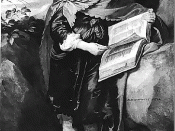During the seventeenth century, many religious and political changes occurred. Cavalier poetry erupted using themes such as love, war, loyalty to the king, and carpe diem. Marvell speaks to his prudish mistress in 'To His Coy Mistress.' Herrick attempts to persuade Corinna to seize the day in 'Corinna's Going A-Maying.' Sir John Suckling speaks to his friend to convince him to forget his love in 'Why So Pale and Wan' Lovelace speaks to his lovers about the limitations placed on relationships and the need to seize the day in 'To Lucasta,' and 'To Althea.' All of these poets emphasize carpe diem, which means seize the day. Marvell, Lovelace, Suckling, and Herrick use the theme of carpe diem to convey the importance of living in the moment. In 'To His Coy Mistress,' Marvell uses the theme of carpe diem to convince his mistress to love him now and not wait forever.
Marvell pleads with his mistress to stop playing hard to get and love while she is still young and pretty. 'Now therefore, while the youthful hue sits on the skin like morning dew...now let us sport us while we may, and now like amorous birds of prey.' Marvell tells his mistress to not wait to love forever, because time will run out. He tells her to seize the day and love him. 'Had we but world enough, and time, this coyness, Lady, were no crime.' Marvell implores his lover to acquiesce his request to live for the moment and abandon her prudish behaviors.
Richard Lovelace writes to his lovers to tell them how he lives in the moment. Although he writes from prison, Lovelace continues to enjoy life and love his mistress in 'To Althea, From Prison.' Lovelace describes how although he is locked in a prison, his mind and...


